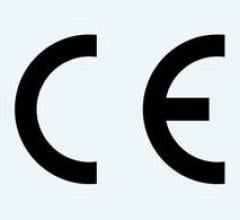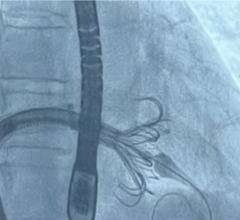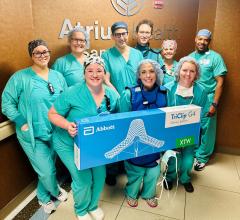
Recently, the U.S. Food and Drug Administration (FDA) has approved the Edwards Sapien transcatheter heart valve for patients with aortic stenosis (AS), who are not suitable for standard aortic valve replacement (AVR). This approval is a landmark event in cardiac medicine and will change the way patients with aortic valve disease are treated.
Up to 1.5 million people in the United States have AS. Approximately 250,000 of these patients suffer from severe, symptomatic AS, often developing debilitating symptoms that can restrict normal day-to-day activities, such as walking short distances or climbing stairs. Aortic stenosis is typically a disease of the elderly, occurring in patients approximately 75 years of age.[1] Although AVR is the standard treatment of AS, at least 50 percent of patients with severe AS do not undergo surgery.[2] Commonly cited reasons include advanced age, left ventricular dysfunction, prohibitive co-morbidities or death before the planned procedure.
As an alternative treatment to AVR, transcatheter aortic valve implantation (TAVI) was initially considered unrealistic and unfeasible by prominent physicians and leaders in the field. Significant time has passed since its conception (prototype development by Percutaneous Valve Technologies Inc.) and the first valve implantation by Dr. Alain Cribier in Rouen, France, in 2002.[4] Several single-center and small multi-center series that included inoperable or very high-risk patients have since shown promising results and confirmed the feasibility of TAVI. In recent years, the technology has developed rapidly and, to date, more than 10,000 transcatheter valves have been implanted worldwide.[5]
From 2007 to 2009, the first randomized clinical trial sponsored by Edwards Lifesciences using the Sapien valve was conducted in 21 centers mainly in the United States. Three hundred and fifty-eight patients who were considered not suitable for AVR were randomized to either TAVI or medical therapy (including balloon aortic valvuloplasty). At one year, mortality in the TAVI group was significantly lower than the medical group (30.7 versus 50.7 percent, CI 0.40-0.74; P<0.001).[6] The composite end-point of death from any cause or repeat hospitalization as well as cardiac symptoms was better in the TAVI group, despite the higher incidence of major strokes and major vascular events.
Based on these results, the FDA approved the Edwards Sapien valve in November 2011 and it is the first TAVI therapy approved for commercial use in the United States. It is indicated for the treatment of patients with severe, symptomatic AS who have been determined by a cardiac surgeon to be inoperable for open AVR, and in whom existing co-morbidities would not preclude the expected benefit from correction of the aortic stenosis.[7]
How Will This Change Clinical Practice?
TAVI is the new standard-of-care for patients with AS who are not eligible for AVR, and may also become an acceptable alternative to surgery in select high-risk (but operable) patients. The evaluation and management of these patients require a multidisciplinary approach under the care of the heart team.[8] The interventional cardiologist and cardiac surgeon bring different skill sets and, together, have expertise with catheter-based therapy, fluoroscopic imaging, aortic root anatomy and open vascular approaches.
What Are the FDA Restrictions?
The Sapien valve is approved for patients with AS who are not suitable for AVR. The product label states that the determination of inoperability is made by the cardiac surgeon. The valve is not approved for patients who can otherwise be treated by standard AVR. Patients who have congenital heart valve anomalies, masses or infection of the hearts, or cannot tolerate anticoagulation/antiplatelet therapy should not receive the Sapien valve.[7]
What is the Durability of the Valve?
Although short- and medium-term outcomes after TAVI are encouraging, long-term data on valve function and clinical outcomes are limited. Surgically implanted, stented bioprostheses in the aortic position have shown 10-year freedom from failure in the range of 60 to 90 percent, with younger patients predisposed toward earlier structural valve degeneration (SVD). Whether the Sapien can achieve similar outcomes is still unknown. Cribier et al. reported on two patients up to two years after TAVI with Sapien valves,[9] and Gurvitch et al. has described clinical outcomes in 70 patients up to 3.7 years with excellent durability.[10] However, durability beyond five years is currently not available for the Sapien valve.
What is the Impact on Patients?
TAVI with the Sapien valve improves survival in patients with AS who are not suitable for AVR when compared with medical therapy. Many studies have reported improvements in the NYHA functional class following TAVI.[4,11,12] Exercise capacity, as evaluated by the six-minute walk test, has also been shown to increase after TAVI. Several studies have shown an improvement in quality of life using the Short Form (SF) 12, SF 36, Kansas City Cardiomyopathy, EuroQuol 5D, and Duke Activity Status Index questionnaires at six to 12 months after implantation.[13-17] Based on improved life expectancy of approximately 1.9 years for TAVI patients over medically treated patients, relative cost-effectiveness was demonstrated at an incremental cost-effectiveness ratio of approximately $62,000 per quality-adjusted life year gained.
The Edwards Sapien valve and TAVI represent the new standard-of-care for AS patients who are otherwise inoperable. Although the long-term durability of the Sapien valve is unknown, TAVI has been shown to improve survival, symptoms and quality of life in the short term.
Editor’s note: Attapoom Susupaus, M.D., is an advanced cardiac surgery fellow at Northwestern Memorial Hospital. S. Chris Malaisrie, M.D., is a cardiac surgeon at Northwestern University Feinberg School of Medicine, Northwestern Memorial Hospital, Bluhm Cardiovascular Institute. He has a particular interest in both transcatheter and minimally invasive aortic valve replacement. Malaisrie also serves as a member of the DAIC Editorial Advisory Board.
References:
1. Nkomo VT, Gardin JM, Skelton TN, Gottdiener JS, Scott CG, Enriquez-Sarano M. “Burden of valvular heart diseases: a population-based study.” Lancet. Sept. 16, 2006; 368(9540): 1005-1011.
2. Bach DS. “Prevalence and characteristics of unoperated patients with severe aortic stenosis.” J Heart Valve Dis. May 2011; 20(3): 284-291.
3. Iung B, Baron G, Butchart EG, et al. “A prospective survey of patients with valvular heart disease in Europe: The Euro Heart Survey on Valvular Heart Disease.” Eur Heart J. July 2003; 24(13): 1231-1243.
4. Cribier A, Eltchaninoff H, Bash A, et al. “Percutaneous transcatheter implantation of an aortic valve prosthesis for calcific aortic stenosis: first human case description.” Circulation. Dec 10, 2002; 106(24): 3006-3008.
5. Kahlert P, Erbel R. “Transcatheter aortic valve implantation in the era after commercialization: quo vadis in the real world?” Circulation. Jan. 25, 2011; 123(3): 239-241.
6. Leon MB, Smith CR, Mack M, et al. “Transcatheter Aortic-Valve Implantation for Aortic Stenosis in Patients Who Cannot Undergo Surgery.” N Engl J Med. 2010.
7. U.S. Food and Drug Administration. “FDA approves first artificial aortic heart valve placed without open-heart surgery.” [press release]. November 2, 2011: http://www.fda.gov/NewsEvents/Newsroom/PressAnnouncements/ucm278348.htm.
8. Holmes DR, Jr., Mack MJ. “Transcatheter valve therapy: a professional society overview from the American College of Cardiology Foundation and the Society of Thoracic Surgeons.” Ann Thorac Surg. July 2011; 92(1): 380-389.
9. Cribier A, Eltchaninoff H, Tron C, et al. “Treatment of calcific aortic stenosis with the percutaneous heart valve: mid-term follow-up from the initial feasibility studies: the French experience.” J Am Coll Cardiol. March 21, 2006; 47(6): 1214-1223.
10. Gurvitch R, Wood DA, Tay EL, et al. “Transcatheter aortic valve implantation: durability of clinical and hemodynamic outcomes beyond 3 years in a large patient cohort.” Circulation. Sept. 28, 2010; 122(13): 1319-1327.
11. Webb JG, Pasupati S, Humphries K, et al. “Percutaneous transarterial aortic valve replacement in selected high-risk patients with aortic stenosis.” Circulation. Aug. 14 2007; 116(7): 755-763.
12. Thomas M, Schymik G, Walther T, et al. “Thirty-day results of the Sapien aortic Bioprosthesis European Outcome (SOURCE) Registry: A European registry of transcatheter aortic valve implantation using the Edwards Sapien valve.” Circulation. July 6, 2010; 122(1): 62-69.
13. Bagur R, Rodes-Cabau J, Dumont E, et al. “Performance-based functional assessment of patients undergoing transcatheter aortic valve implantation.” Am Heart J. April 2011; 161(4): 726-734.
14. Bagur R, Rodes-Cabau J, Dumont E, et al. “Exercise capacity in patients with severe symptomatic aortic stenosis before and six months after transcatheter aortic valve implantation.” Am J Cardiol. July 15, 2011; 108(2): 258-264.
15. Gotzmann M, Hehen T, Germing A, et al. “Short-term effects of transcatheter aortic valve implantation on neurohormonal activation, quality of life and 6-minute walk test in severe and symptomatic aortic stenosis.” Heart. July 2010; 96(14): 1102-1106.
16. Krane M, Deutsch MA, Bleiziffer S, et al. “Quality of life among patients undergoing transcatheter aortic valve implantation.” Am Heart J. Sept. 2010; 160(3): 451-457.
17. Reynolds MR, Magnuson EA, Lei Y, et al. “Health-related quality of life after transcatheter aortic valve replacement in inoperable patients with severe aortic stenosis.” Circulation. Nov. 1, 2011; 124(18): 1964-1972.



 March 04, 2025
March 04, 2025 








